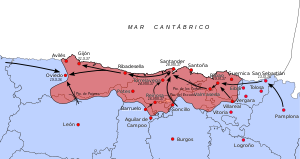| Revision as of 05:32, 11 November 2008 editCarlson288 (talk | contribs)Extended confirmed users5,446 editsNo edit summary← Previous edit | Revision as of 19:46, 16 December 2008 edit undo201.198.133.51 (talk)No edit summaryNext edit → | ||
| Line 6: | Line 6: | ||
| |date= | |date= | ||
| |place= Biscay, Northern ] | |place= Biscay, Northern ] | ||
| | territory = Nationalists win Biscay from the |
| territory = Nationalists win Biscay from the republicans | ||
| |result=Decisive Nationalist victory | |result=Decisive Nationalist victory | ||
| |combatant1={{flagicon|Spain|1931}} ]<br/>{{flagicon|Basque Country}} ] | |combatant1={{flagicon|Spain|1931}} ]<br/>{{flagicon|Basque Country}} ] | ||
Revision as of 19:46, 16 December 2008
| Battle of Bilbao | |||||||
|---|---|---|---|---|---|---|---|
| Part of the Spanish Civil War | |||||||
 The Northern Front. Bilbao is on the right of the red area. | |||||||
| |||||||
| Belligerents | |||||||
|
|
| ||||||
| Strength | |||||||
| 50,000 troops and milita |
60,000 Nationalist troops 15,000 Italian troops | ||||||
| Casualties and losses | |||||||
| Unknown |
Nationalist: Unknown Italian: 105 dead 427 wounded three missing | ||||||
The Battle of Bilbao was part of the War in the North, during the Spanish Civil War where the Nationalist Army captured the city of Bilbao and the remaining parts of the Basque Country still held by the Republic.
Bilbao was the capital of the autonomous Basque area established by the Republic after the war began. This establishment was in payment for Basque Nationalist support of the Republic. Not all Basques supported the Basque Nationalists, however.
The Basque people in Spain generally inhabit four provinces, Navarre, Alava, Guipuzcoa and Vizcaya. The Basque Nationalists were only dominant in the latter two provinces.
Navarre and Alava had rallied to the rising against the Republic.
The Nationalists gained Guipuzcoa early in the war with the fall of San Sebastián, September 13, 1936.
By June 11 The Basque forces had fallen back to the city of Bilbao, which was defended by a series of rushed fortifications called the "Iron Belt." Unfortunately, the Iron Belt was poorly designed for defense and the designer of the Belt, engineer Alejandro Goicoechea, defected to the Nationalists and brought them the plans of the defenses, so that they could strike at the weakest point . The ring was breeched by an infantry assault supported by heavy artillery bombardment. On the night of June 13 the defenders evacuated most of the civilian population from the city. On June 18 General Ulibarri withdrew his remaining troops from Bilbao and the Nationalists occupied the city on the following day. The city's bridges had been destroyed to hinder the invaders but the city remained mostly intact.
Notes
- Gabriel Jackson, The Spanish Republic and the Civil War, 1931-1939 (1965), p. 384
- Hugh Thomas, The Spanish Civil War, (2001), p. 397
- Gabriel Jackson, pp. 380-384.
- Manuel Montero García, History of Biscay (1980).
This Spanish history–related article is a stub. You can help Misplaced Pages by expanding it. |